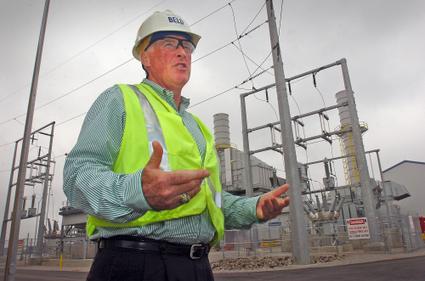
Braintree’s new power plant will generate income as well as electricity
By Fred Hanson
The Patriot Ledger
Last update Jul 07, 2009 @ 08:50 AM
BRAINTREE — The whirring sound as it comes to life seems familiar. It’s like the engine noise of a jet accelerating down a runway just before takeoff, only softer.
Inside the metal housings of the Braintree Electric Light Department’s Thomas A. Watson Generation Stations are two Rolls-Royce Trent 60 engines.
“They’re the same jet engine that’s on a Boeing 777,” said William Bottiggi, the department’s general manager.

AMELIA KUNHARDT/The Patriot Ledger
William Bottiggi, general manager of the Braintree Electric Light Department, says he expects the new Watson generating plant to break even in its first year of operation.
Yet, a few feet away from the units, the noise is only about 85 decibels, about the same as what an electric razor makes.
After nearly five years of planning, permitting and construction, the $110 million Watson plant began generating commercial power on June 23. The second unit at the plant completed testing last Tuesday.
The plant covers a 2-acre site on the shore of the Fore River that housed the department’s original Potter I generating plant, which was built more that a half-century ago and decommissioned in the early 1980s.
Designed to operate both on natural gas and ultra-low-sulfur diesel fuel, the new plant will go into operation when demand for power is at its highest, Bottiggi said.
“These units will go from cold to full power in 10 minutes,” he said. “It takes hours and hours to get the older plants running. They can’t respond like we can.”
On a recent afternoon when the sun came out and demand for electricity rose with the temperature, the plant was able to make a $15,000 profit in an hour of operation, he said.
“It’s very weather-dependent,” said Bottiggi, adding that the plant’s capacity is needed much more in the summer and winter than in the spring and fall.
In addition to producing revenue, the plant will protect customers from rate spikes, Bottiggi said.
The benefits are shared with six other municipal light departments and the New Hampshire Electric Cooperative, which have purchased shares of the plant’s output. Braintree has retained 30 percent of the plant’s capacity.
Braintree homeowners should also see the benefits of the new plant, in the form of lower monthly bills. A customer using 650 kilowatts of electricity a month will pay $5 less for it.
Bottiggi expects the plant to break even in its first year of operation.
“The residents own us,” he said. “Any extra money, we give back to the ratepayers.”
He expects another rate cut either later this year or early next year.
On a recent tour, he pointed out the station’s pollution-control features, including equipment that removes minerals from the water used to generate steam and a tank that holds the ammonia that is added to the generators’ exhaust.
“All that comes out of the stacks is nitrogen, water vapors and carbon dioxide,” Bottiggi said.
The Watson plant and the town’s Potter II station can generate three times as much electricity as town uses on an average day. The department also has the capacity to operate “as an island,” maintaining the power supply to its customers in the event of a regional blackout like the one in 1965.
Fred Hanson may be reached at fhanson@ledger.com.
A history of the Braintree Electric Light Department
1891: Voters authorize the construction of a generating station to power street lights in town. The plant, built on Allen Street at a cost of $25,000, goes into operation the following year and is quickly expanded to provide power for lights at homes and businesses.
1909: A municipal light board is created to manage the department, which had been overseen by the town’s selectmen.
1957: Growth of the town leads to the construction of the $5 million Potter I plant. The plant runs until 1980, then is torn down to make way for the Watson plant.
Nov. 9, 1965: About 25 million people from Ontario to New Jersey are without electricity because of a massive blackout. The lights stay on in Braintree, which is not tied into the power grid, and in Taunton.
1967: Braintree ties into the Boston Edison system to purchase power when needed and sell excess power.
1973: A $20 million bond is approved for the construction of the Potter II generating station. The station is completed four years later.
1992: The Allen Street complex, at the site of the original generating station, is razed.
1998: The department offers broadband Internet service to residents.
2000: Cable TV service is introduced.
2009: The Thomas A. Watson Generating Stations begin operating.
Sources: Braintree Electric Light Department, Patriot Ledger archives
THOMAS AUGUSTUS WATSON
Watson is best known as the recipient of the first-ever telephone call, which was made by Alexander Graham Bell on March 10, 1876. He also played a major role in the town of Braintree, where he settled on a 60-acre farm in 1883. He started the Fore River Shipyard, later moving it down river to Quincy Point. He chaired the committee that recommended the creation of a municipal power plant and served without pay as the plant’s first general manager. He also served on the town’s school committee for 18 years, advocating for more modern school buildings and the creation of a kindergarten program.
